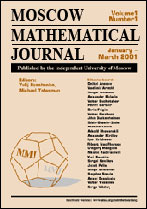|
This article is cited in 33 scientific papers (total in 33 papers)
Interlocking of convex polyhedra: towards a geometric theory of fragmented solids
A. J. Kanel-Belovabc, A. V. Dyskind, Y. Estrinef, E. Pasternakg, I. A. Ivanov-Pogodaevh
a Moscow Institute of Open Education, Moscow, Russia
b Department of Mathematics, Bar Ilan University, Ramat Gan, Israel
c International University Bremen, Bremen, Germany
d School of Civil and Resource Engineering, The University of Western Australia, Crawley, WA, Australia
e ARC Centre of Excellence for Design in Light Metals, Department of Materials Engineering, Monash University, Clayton, Vic., Australia
f CSIRO Division of Manufacturing and Materials Technology, Clayton, Vic., Australia
g School of Mechanical Engineering, The University of Western Australia, Crawley, WA, Australia
h Department of Mechanics and Mathematics, Moscow State University, Moscow, Russia
Abstract:
The article presents arrangements of identical regular polyhedra with very special and curious properties. Namely, the solids are situated in a sort of a layer and are interlocked in the sense that no one of them can be moved out without disturbing others. This situation cannot happen in the plane. First examples of this sort (composed of irregular convex polyhedra) were complicated and were constructed in a non regular way by G. Galperin. The examples presented here were constructed in framework of applied studies by the authors, C. Khor and M. Glickman and were not described in mathematical publications. The full version of this paper is presented here: http://arxiv.org/abs/0812.5089.
Key words and phrases:
interlocking structures, combinatorial geometry, convex polyhedron, tilling.
Received: November 7, 2006; in revised form January 7, 2007
Citation:
A. J. Kanel-Belov, A. V. Dyskin, Y. Estrin, E. Pasternak, I. A. Ivanov-Pogodaev, “Interlocking of convex polyhedra: towards a geometric theory of fragmented solids”, Mosc. Math. J., 10:2 (2010), 337–342
Linking options:
https://www.mathnet.ru/eng/mmj383 https://www.mathnet.ru/eng/mmj/v10/i2/p337
|

|



 Contact us:
Contact us: Terms of Use
Terms of Use
 Registration to the website
Registration to the website Logotypes
Logotypes